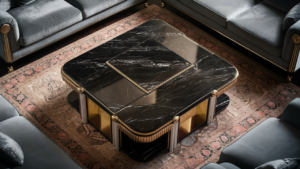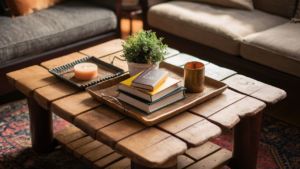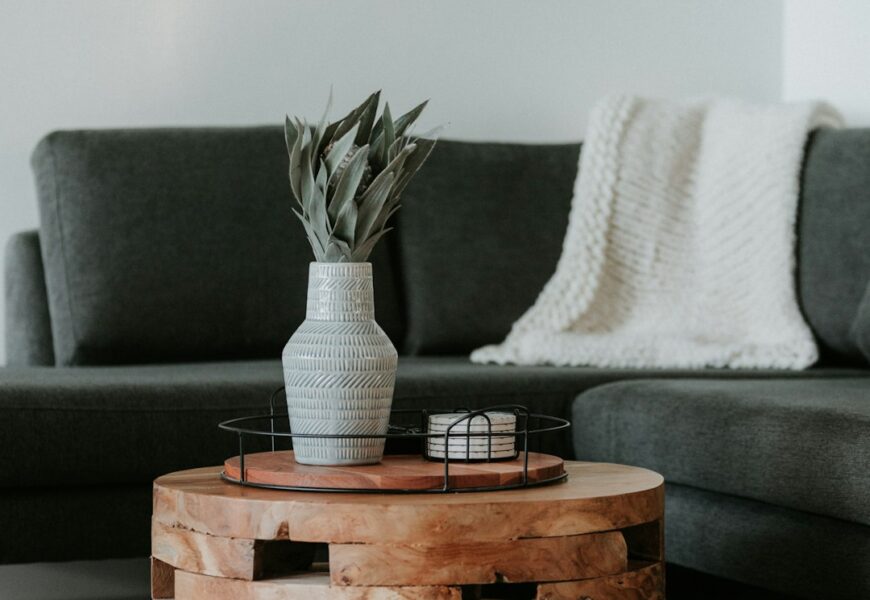Introduction
Welcome to the quest for the perfect coffee table for your living room! When it comes to interior design, choosing the right coffee table not only complements your living room decor but also enhances functionality. Whether you’re redecorating from scratch or simply updating your space, the coffee table serves as a focal center, dictating the flow and aesthetics of the room. In this blog post, we’ll guide you through the key considerations to ensure you find a table that fits your style, meets your needs, and transforms your living room into a cozy, inviting space. From size and shape to material and style, we’ve got you covered with practical advice to make an informed decision.
Factors to Consider When Choosing a Coffee Table

Size and Shape
Choosing the right size and shape for your coffee table is crucial because it can greatly affect both the functionality and aesthetic appeal of your living room. Start by considering the dimensions of your space. A good rule of thumb is to select a table that is about two-thirds the length of your sofa. This size provides balance in the room and ensures the table isn’t too overpowering or too insignificant. Regarding height, it’s generally best to pick a table that is the same height as the seating cushions on your sofa or one to two inches lower.
When it comes to shape, think about the layout of your room and the flow of traffic. Rectangular and oval tables work well in longer rooms or larger seating configurations, allowing easy movement around the table. Square and round tables are ideal for smaller rooms or square seating configurations, as they can create a more intimate and cozy atmosphere with equal access for everyone seated around them.
Style and Material
The style and material of your coffee table can define the character of your living space. Wooden coffee tables bring a warm, classic feel to a room and can range from elegant antique finishes to modern minimalist designs. Glass tables, on the other hand, can enhance a feeling of openness and light. They are particularly suitable for smaller rooms or spaces that aim to maintain an airy, uncluttered look.
Metal tables can add an industrial edge to your room, often serving as a modern touch in more traditional spaces or complementing a contemporary design scheme. Besides aesthetics, consider the durability and care required for each material. For example, glass can be easy to clean but is more prone to fingerprints and smudges. Wood offers durability but may require regular maintenance to keep it looking beautiful.
Functionality and Storage Options
If your living room also serves as a hub for family activities, consider the functionality of your coffee table. Many tables now come with built-in storage options such as drawers, shelves, or even small cabinets. This can be a perfect way to reduce clutter and keep living room essentials, like remotes, magazines, and coasters, out of sight but easily accessible.
For multifunctional spaces, look for tables that offer additional uses. Lift-top coffee tables are a fantastic choice as they can be elevated to serve as a desk or dining table, making them ideal for small spaces or apartments where flexibility is key.
Matching Your Coffee Amazon to Your Living Room Decor
Color and Finish
The color and finish of your coffee table can either make it blend in or stand out in your living room. When choosing the finish, think about the color scheme of the room. Classic neutrals, like blacks, whites, and browns, are versatile and can harmonize with almost any design palette. Bold colored tables can be a focal point and add vibrancy and personality to more neutral settings.
Consider the finish as well — glossy surfaces can add a touch of glamour and sophistication, while matte finishes can help create a more understated, modern look. Additionally, translucent finishes in a glass or acrylic material can make a small space seem larger and more open.
Complementing Existing Furniture
To achieve a cohesive look in your living room, your coffee table should complement the other pieces of furniture in the space. Consider the styles and patterns of your existing decor. A minimalist coffee table with clean lines fits well in a modern living room, while a rustic wooden table might better suit a room with a country or traditional setting.
Also, take into account the scale of the furniture around it. A large, bulky sofa can handle a heavier, larger table, whereas a sleek, low-profile sofa might pair better with a slim, more delicate table.
Creating a Focal Point
A coffee table can serve as much more than a functional item; it can also be the focal point of your living room. To make your coffee table stand out as a centrepiece, consider its styling. A dramatic sculpture, a stack of art books, or an intricate floral arrangement can draw attention to the table.
When designed thoughtfully, a coffee table not only complements your living room’s decor but also enhances it, contributing significantly to the overall ambiance of your home. Choose a table that speaks to your personal style while meeting your practical needs, and it will serve as a charming central piece in your living room for years to come.
Coffee Table Styling Tips

Layering Decorative Items
Creating a visually appealing coffee table setup involves thoughtful layering of decorative items that not only enhance the aesthetic of your living room but also reflect your personal style. Start by selecting a centerpiece that draws attention—this could be a large vase, a sculptural object, or an artistically arranged stack of books. Around this centerpiece, add smaller accents like candles, coasters, or trinkets. If you have a rectangular table, arrange items symmetrically for balance; if your table is circular, you might opt for a more central grouping to maintain harmony. Remember to vary the height and texture of the items to add depth and intrigue to the arrangement.
Incorporating Practical Elements
While it’s important for your coffee table to look good, it also needs to be functional. This is where incorporating practical elements comes into play. Ensure your coffee table serves its purpose by including items that enhance usability. This might mean having a small tray to organize remotes or coasters to protect the surface. If you often read in your living room, consider having a chic magazine rack or a decorative bowl filled with reading glasses nearby. Additionally, if space allows, you can place small, woven baskets under the table for extra storage. These baskets can hold anything from extra cushions and blankets to your favorite board games.
Balancing Form and Function
The art of selecting the perfect coffee table is finding the sweet spot between form and function. Your table should not only complement the interior design of your living entered but also cater to your lifestyle needs. If you often host gatherings, choose a table that is sturdy and perhaps has an extra shelf or drawers for additional functionality. For smaller spaces, a glass table or one with a minimalist design can help the room feel more open and less cluttered. Always consider the scale of the table in relation to your sofa and the rest of the room; a table that is too large can overwhelm the space, while one that is too small may not be as functional. Lastly, keep maintainability in mind—opt for materials that are easy to clean and maintain, especially if you have pets or children.
Conclusion
Selecting the perfect coffee table for your living room is both an art and a science. It requires a balance of functionality and aesthetic appeal, ensuring it complements your lifestyle and decor. By considering the shape, size, material, and function of your coffee table, you will enhance not only the appearance but also the usability of your living space. Feel free to express your style and remember that the right coffee table can redefine your living room’s ambiance and utility. Enjoy the process of selection and make your living room a reflection of your personal taste and comfort!









